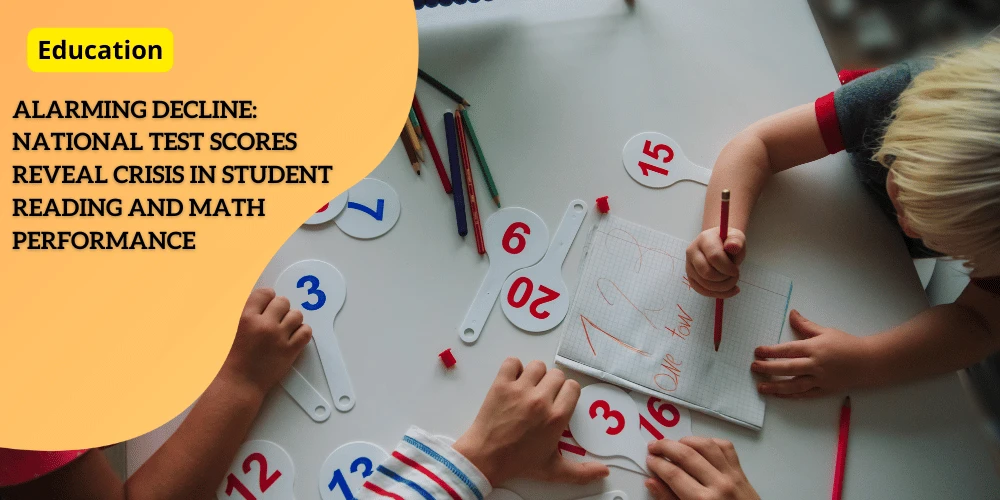Alarming Decline: National Test Scores Reveal Crisis in Student Reading and Math Performance

Anúncios
Overview of the National Test Score Crisis
National Assessment of Educational Progress Findings
The latest results from the National Assessment of Educational Progress (NAEP) reveal a worrying decline in both reading and math skills among U.S. students.
The data highlights significant drops in the performance of fourth and eighth graders, particularly when compared to pre-pandemic levels.
Anúncios
These findings underscore the profound impact that pandemic-related disruptions, such as prolonged school closures and the shift to remote learning, continue to have on student achievement nationwide.
Significant Decline in Reading and Math Skills
The assessment data indicates that on average, reading scores have plummeted by five points, affecting both grade levels.
Anúncios
Students who were already performing at lower levels before the pandemic have suffered the most severe setbacks.
This decline is largely attributed to a decrease in student interest in traditional reading, along with increased time spent on digital devices, which seems to be affecting reading comprehension negatively.
When it comes to math, the situation is equally troubling.
Fourth graders scored three points lower than their pre-pandemic counterparts, while eighth graders experienced a more pronounced decline with an average drop of eight points.
This decrease in math performance is significant and suggests long-term implications for students’ academic trajectories.

Pandemic-Related Impact on Student Learning
Pandemic-related disruptions have played a crucial role in driving these declines.
The switch to remote learning, coupled with inconsistent access to educational resources, has left many students struggling to keep up.
The data reflects how these disruptions have disproportionately affected students who were already at an academic disadvantage, exacerbating existing educational inequalities.
Additionally, higher absenteeism rates among struggling readers have contributed to the downward slide in literacy skills.
Many students have also missed out on traditional reading and writing exercises, which are essential for developing strong language skills.
Despite these alarming trends, there are positive signs that recovery is possible.
Some regions have seen improvements in test scores, and there’s hope that targeted interventions and renewed focus on traditional educational practices can help reverse these declines.
As we move forward, understanding these trends and addressing the underlying causes will be critical to supporting students in their academic recovery journeys.
Reading Score Analysis
The latest data from the National Assessment of Educational Progress reveals an average 5-point decline in reading scores for both fourth and eighth graders compared to pre-pandemic levels.
For fourth graders, the scores dropped from 220 to 215, and for eighth graders, the scores dipped from 263 to 258.
This decline is concerning, particularly for lower-performing students who experienced even more severe setbacks.
Impact on Lower-Performing Students
Lower-performing students have seen their reading scores fall even more sharply than the national averages.
These students were already at a disadvantage and the pandemic has only magnified the gap.
As Peggy Carr, commissioner of the National Center for Education Statistics, highlighted, the pandemic-related disruptions have exacerbated existing challenges in reading.
Unfortunately, this has led to a more pronounced decline for those already struggling.
According to Carr, absenteeism among lower-performing readers has worsened, contributing further to their literacy slide.
Diminishing Interest and Changing Habits
Another contributing factor to the decline in reading scores is the diminishing interest in traditional reading.
Students are increasingly using digital devices for reading, which tends to involve shorter and less complex passages than traditional texts.
As a result, reading comprehension skills are not being developed as robustly as in previous generations.
Carr points out that teachers are assigning fewer essays and written responses, which diminishes opportunities for students to engage deeply with the material.
The combined effects of reduced interest in traditional reading and increased screen time are clear contributors to the downward trend in reading scores.
This shift in habits underscores the need for educational strategies that can bridge the gap and rekindle a love for reading among students.
These components reflect the broader challenges facing the educational system and emphasize the urgency of addressing these issues.
Specific interventions aimed at re-engaging students with traditional reading practices could be crucial in reversing these trends.
Focused support for lower-performing students, including measures to reduce absenteeism, could also play a significant role in helping these students catch up.
Mathematics Performance Trends
The pandemic has left a noticeable impact on students’ math skills, reflected in the latest National Assessment of Educational Progress results.
Sadly, both fourth and eighth graders have shown significant declines in their math performance compared to pre-pandemic levels.
Fourth Grade Performance
Fourth graders’ math scores have dipped by an average of 3 points compared to pre-pandemic years.
While this may seem minor, it represents a broader trend of declining math skills among young learners.
The disruption to regular school schedules and the shift to remote learning have undoubtedly played a role in this decline.
Eighth Grade Decline
For eighth graders, the situation is even more concerning, with an average score drop of 8 points.
This is a substantial decrease and highlights the enduring challenges middle school students face in grasping essential math concepts.
The longer period of remote learning and the multifaceted nature of math at this level are likely contributing factors.
Widening Achievement Gap
The achievement gap between high-performing and low-performing eighth-grade students has reached historic levels.
While some top students have managed to maintain or even improve their scores, many lower-performing students have fallen further behind.
This widening gap is a pressing issue, as it underscores the need for targeted interventions to support struggling learners.
The decline in math performance serves as a stark reminder of the pandemic’s prolonged impact on educational outcomes.
It also emphasizes the importance of developing strategies to help students recover and excel in mathematics.
Contributing Factors to Academic Decline
Increased Reliance on Digital Devices
One of the most significant contributors to the national test score crisis is the increased reliance on digital devices.
The shift to online learning during the pandemic intensified the use of these devices, affecting students’ reading comprehension skills.
Unlike traditional reading materials, digital texts often encourage skimming rather than deep, focused reading.
This shift has made it harder for students to retain and understand complex information.
Moreover, the interactive nature of digital content can be distracting, leading to decreased comprehension and engagement.
Higher Absenteeism Among Struggling Readers
Absenteeism is another factor that has exacerbated the decline in academic performance, particularly among struggling readers.
The pandemic led to unprecedented disruptions in schooling, causing many students to miss significant amounts of instructional time.
This absenteeism is especially detrimental to lower-performing readers, who require consistent practice and support to improve their literacy skills.
Peggy Carr, commissioner of the National Center for Education Statistics, noted that lower-performing readers are more likely to be absent, further contributing to their academic setbacks.
Reduced Emphasis on Traditional Reading and Writing
The ongoing shift away from traditional reading and writing exercises is another contributing factor to the decline in academic performance.
During the pandemic, educators had to adapt quickly to new teaching methods, often at the expense of traditional practices.
This reduction in traditional exercises means students are getting fewer opportunities to develop essential reading and writing skills.
As Carr mentioned, the joy for reading is declining, partly because teachers are assigning fewer essay responses and students are reading less.
These contributing factors have significantly affected reading and math performance among U.S. students.
Addressing these issues will be crucial for educational recovery and improvement.
The next chapter will discuss some of the bright spots and hopeful signs that suggest potential pathways for recovery.
| Contributing Factor | Description |
|---|---|
| Increased Reliance on Digital Devices | The shift to online learning increased screen time, which affected reading comprehension due to skimming and distractions in digital content. |
| Higher Absenteeism Among Struggling Readers | Absenteeism during the pandemic led to missed instructional time, which is particularly harmful to lower-performing readers who need consistent practice. |
| Reduced Emphasis on Traditional Reading and Writing | The shift away from traditional reading and writing exercises reduced opportunities for students to develop essential literacy skills. |
Bright Spots and Hope for Recovery
Despite the troubling news about declining reading and math scores, there are glimmers of hope that suggest recovery is possible.
Several states have shown positive trends, giving educators and policymakers reasons for optimism.
Louisiana’s Reading Success
Fourth graders in Louisiana have bucked the national trend by improving their reading scores compared to pre-pandemic levels.
This achievement is a testament to the state’s focused efforts on literacy programs and targeted interventions.
Schools in Louisiana have emphasized reading through immersive and engaging methods, fostering a love for literature among young learners.
The improvement in scores is evidence that these strategies are indeed making a difference.
Alabama’s Math Gains
Alabama is another state showing encouraging signs, particularly in fourth-grade math performance.
Unlike many other regions, Alabama’s fourth graders scored higher in their math assessments than they did before the pandemic.
This success could be attributed to the state’s proactive approach in integrating innovative math teaching techniques, such as hands-on activities and real-world problem-solving.
By making math learning more relatable and enjoyable, Alabama has managed to help its students excel during challenging times.
Positive Trends in High-Performing Student Segments
High-performing students across various states are also showing positive trends.
For instance, high-performing eighth graders have made significant improvements, especially in math.
These gains underscore the importance of fostering a challenging and supportive learning environment.
It suggests that when students are adequately supported and motivated, they can achieve remarkable success, even amid broader educational challenges.
The bright spots in Louisiana and Alabama show that tailored, focused educational strategies can yield positive results.
These examples provide valuable insights for other regions grappling with learning losses.
While the road to recovery is long, these successes offer a blueprint that can guide future efforts to improve student outcomes nationwide.
By examining these successes, educators can glean insights on effective methods to bolster student learning.
This exploration into promising educational practices allows for a deeper understanding of how to address the current academic crisis effectively.







